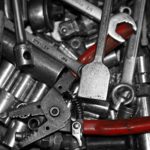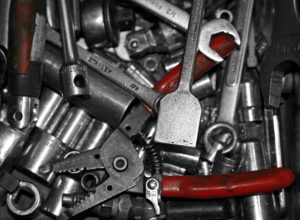You've just got your new re manufactured engine and you're ready to install it in your ride. An engine is a huge investment so you want to make sure you properly install it for years of reliable performance. Here are the top 5 failures related to engine installation and how to avoid them.
Learn about how our engines are re manufactured right here in the U.S.A.
The 5 installation errors below are far and away the most common failures we see right after or shortly after the engine is installed. The good news that every one of these issues is completely avoidable! In addition to following the warnings below it's always a good idea to research any TSBs (Technical Service Bulletins) related to common failures for the specific engine you're working on.
Create an account with us for promotions and more information about the industry!
Foreign Debris
Many popular late model engines are notorious for dropping intake seats. These powdered metal seats break into small fragments and become lodged into the intake manifold. If you do not properly clean the intake they will get sucked into the new engine and contaminate it, causing damage to the new engine.
We highly recommend the intake manifold assembly be replaced to eliminate this problem. If you choose not to put a new intake on, the existing intake must be thoroughly cleaned.
To clean the intake, begin by removing the throttle body and standing the intake on end. Blow air through the intake ports to help dislodge some of the foreign debris. Collect debris with a powerful magnet. Be sure to thoroughly shake the intake and use a light to check the corners so you don’t miss any of this material.
Measuring exhaust back pressure
This information is provided as a general guide; if you need more specific information please call our toll free number for technical assistance.
How to do it:
Remove the front oxygen sensor; if it is a V style engine or has multiple catalytic converters remove each of them individually.
Test the back pressure between the engine and the catalytic converter using a back pressure test kit. If you do not have a back pressure test kit any low pressure gauge will work.
Warm up the engine and run it at a steady 2200 rpm, then read the gauge. 1-2 pounds is acceptable, but anything over 2 pounds means there is a restriction.
Why checking the back pressure is important:
When you are replacing an engine it is extremely important to check the exhaust back pressure. A restricted exhaust system means that the exhaust system is not functioning properly which can lead to premature engine failure including burnt valves or blown head gaskets. Engine failure caused by a restricted exhaust system is not covered under your warranty (no matter who you buy the engine from!) so it is in everyone’s best interest to measure back pressure when installing a new engine.
Oil cooler replacement warning
There are many different shapes and sizes of oil coolers being used in today’s engines. Most of these are unique to the application and OE manufacturer design. Common among all coolers are the extremely small oil passges that make up the “bundle” or “element” housed in the interior of the cooler. The cooling surface is maximized by keeping the individual tube’s diameter as small as possible.
This design makes it necessary to replace the oil cooler bundle or element after bearing failures, cylinder wall scoring or any other type of catastrophic engine failure that produces debris inside the engine. Remains from a failure become trapped inside the oil cooler and cannot be removed by degreasing or flushing the cooler. Trapped particles are likely to reenter the remanufactured engine’s lubricating oil supply causing a repeated failure.
New oil cooler bundles are available from various OE and aftermarket sources. It is highly recommended you replace the entire radiator assembly.
Engine oil coolers must be replaced or any engine warranty will be void.
Priming Your Engine
Engine remanufactures have historically had a very small percentage of engine failures related to oil pumps and related parts, but over the past several years these failures seem to be increasing. There seems to be three common denominators associated with these failures; the engines were shipped over 200 miles to the installer, the engine sat in a warehouse for at least a month, and/or the engine was difficult to prime.
Priming the engine prior to startup is even more critical when the bearings and other major components do not have lubrication left on them from factory testing. Examples of this would be if an engine is on the warehouse shelf for an extended period of time, or the oil/lubrication shaking during transit.
Because of constant advances in technology of engines, priming has become more difficult over the years. In the past, installers were able to simply spin the oil pump with a drill before installing the distributor. Today, there are so many variations of engines that are distributor less and/or drive the oil pump off other accessories. Examples of this include Quad 4 GM engines that use an oil pump driven by a gear on the crankshaft, imports like the 2.6L Mitsubishi which uses a chain to drive the pump, and others that use a gerotor style oil pump that is driven directly by the crankshaft.
In these cases, priming the oil system by turning the oil pump can be very difficult or even impossible. To avoid dry start problems and properly prime the system, the installer must attach a pressure primer to the oil galley to pump oil through the engine.
Fuel Quality
If your vehicle has sat for more than 30 days prior to new engine installation you must clean out the fuel tank and install fresh fuel. Today’s low quality fuels contain ethanol which has properties that can cause fuel contamination from exposure to air. Stale fuel can cause valve train and internal engine component failure.
While these are all problems that happen, you can rest assured that Tristar Engines has you covered! Our made in the US made quality products used in re manufacturing minimize any of these potential issues, and our No Fault Warranty available on our engines is the assurance you need for any installation.
Check out our process here, all made in the U.S.A
Continue Reading





